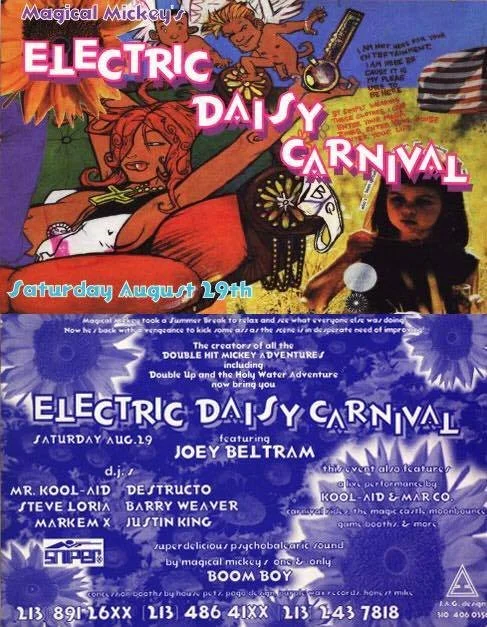Underground to Mainstream
The Underground
Electric Daisy Carnival, 1990 flyer
Electronic Dance Music (EDM), a genre that now resonates with millions worldwide, had humble and often misunderstood beginnings. The roots of EDM trace back to the 1970s and 1980s, when pioneers like Kraftwerk and Jean-Michel Jarre began experimenting with electronic synthesizers to create new soundscapes. These initial concerts, often held in small venues or underground clubs, were critical in shaping the genre. However, they were frequently met with skepticism and criticism. Traditional music critics and audiences often dismissed these electronic sounds as "not real music," unfavorably comparing them to more conventional bands of the time. Despite this, artists continued to innovate, laying the foundation for what would become a global phenomenon.
The Birth of Rave Culture
As EDM began to gain traction, it found a home in clubs and unconventional spaces like abandoned industrial buildings, ruins and barns. These venues, often operating on the fringes of legality, fostered a unique party atmosphere distinct from traditional music scenes. It was here that the term "rave" began to circulate, a term believed to have been coined in the UK during the late 1980s. The rave scene was inextricably linked with the rise of MDMA, also known as ecstasy, particularly in the UK. This association with drug culture played a significant role in shaping the rave experience, emphasizing sensory enhancement and communal euphoria. Despite its growing popularity, the rave scene remained largely underground, with a reputation for being the antithesis of mainstream music culture.
Staying Underground: The Rave Era in the US
In the United States, the rave culture maintained its underground status for a considerable time. Organizers employed various methods to evade law enforcement and societal scrutiny, from handing out flyers in secret to utilizing emerging list servers for communication. Notable events that captured the essence of this era included parties in abandoned warehouses in major cities and impromptu desert gatherings, such as Frankie Knuckles “Storm Rave” in Brooklyn, “Electric Daisy Carnival” in Los Angeles, and “Burning Man” in California. These events were more than just parties; they were a form of rebellion against the mainstream music industry and a celebration of alternative art and culture.
From Rave to Festival: The Emergence of a New Era
The transition from rave culture to festival culture marked a significant shift for EDM. No longer confined to illegal warehouses, electronic music began to be celebrated in city parks, forests, beaches, and more organized venues. Early electronic festivals, such as the reboot of “Electric Daisy Carnival” via the purchase by Pasquale Rotelli (Insomniac) in 1995, as well as “Organic 96” in San Bernardino in California and “Even Further” in Wisconsin both in 1996, set the stage for this transformation. These festivals retained the spirit of rave culture while adapting to larger, more diverse audiences. The music industry, recognizing the potential of EDM, began to invest in these festivals, introducing commercial elements like sponsorships and merchandise.
The Rise of Mega-Festivals
As EDM continued to grow in popularity, some initial festivals struggled to keep up, while others like Tomorrowland (first edition, 2005), Ultra Music Festival, Creamfields, and Coachella, evolved into industry juggernauts. These festivals now attract millions of fans annually, featuring a diverse array of artists and elaborate production designs. They have become a staple in the music festival calendar, drawing audiences from all corners of the globe and showcasing the wide-ranging appeal of EDM.
EDM Today: Mainstream Success and Future Prospects
Today, EDM has transcended its underground origins to become a major component of the music industry. What once symbolized the outsiders of society, known for its exploration of new music genres, drug culture, and immersive sensory experiences, now stands at the forefront of mainstream music. This raises the question: can EDM maintain its distinctive edge under the spotlight of popular culture? The genre's vast array of sub-genres and global accessibility (for emerging artists and fans) suggest that it can adapt and thrive amidst the pressures of pop culture.

